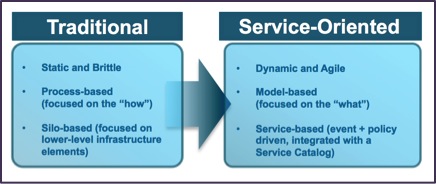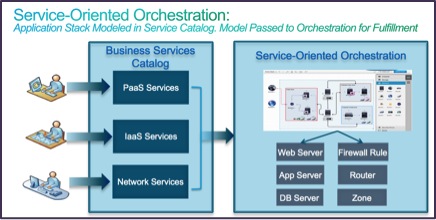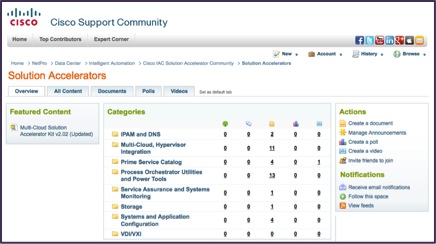































Let's talk about Cisco Process Orchestrator. We recently released version 3.0 - and there are a lot of exciting features that have been introduced with this new release of our IT Process Automation (ITPA) / Run Book Automation (RBA) software.
Cisco Process Orchestrator is the foundational engine on which Cisco has built a number of data center-, application-, and network-focused automation solutions. These include our cloud management solution (Cisco Intelligent Automation for Cloud), which embeds this orchestration engine for cloud service automation and helps organizations deploy private, public, or hybrid clouds; an SAP-focused solution resold by SAP (SAP IT Process Automation by Cisco), which lowers TCO of your SAP applications and databases by integrating events and alert management data with incident response information; and a network troubleshooting and triage solution, which helps customers manage repetitive tasks and aids remediation of common issues with network operations.
In this post, I'm going to feature a few of the major highlights of the new version 3.0 release:
Service-Oriented Orchestration
Building ITPA and RBA workflows has never been easier. With Cisco Process Orchestrator's service-oriented orchestration you can move away from traditional static, script-based run-book automation and IT process-level automation. We have built a modeling platform where automation aligns with the highest-level services and allows you to model IT service the way that a high-level service is delivered.
 A shift from static workflow design to dynamic, service-oriented design
A shift from static workflow design to dynamic, service-oriented design
In this "top down" approach, designing the services and their desired state is the initial step in automation design. The next step is defining the process actions for these services and then implementing the specific process workflows that traverse traditional IT boundaries to act on and automate the necessary elements to deliver the service.
This ultimately gives you an easy to define, easy to manage, "business centric" and "service-oriented" approach to automation that focuses on the end results rather than spending hours architecting a workflow from inside out.
We aren't jettisoning the traditional workflow process; some services and workflows are element-specific or silo-specific. However, these new service-oriented capabilities augment and complement the traditional approach so that you can model in both service-oriented and process-based orchestration. It also means that you can easily take these discrete, element-based workflows and leverage them for modeling and delivering cross-silo, service-oriented orchestration.
 An example of service-oriented orchestration -for automation of an end-to-end application stack
An example of service-oriented orchestration -for automation of an end-to-end application stack
Automation Packs and Accelerators
With Cisco Process Orchestrator, service-oriented workflows can be saved and encapsulated as automation packs that are version controlled - enabling your internal operations teams and the broader partner community to define new types of services and augment those developed by others.
For instance, a customer support service can be provided by a distributed application. It consists of a number of web servers behind a load balancer, a database, a cluster of application servers, and a policy repository for user credentials. Each topology node fits within your network, with each tier separated by firewalls, which require specific firewall configuration, so the application topology has relationships to a network topology. All these elements together form the service topology.
To this end, you need to define the service topology and application blueprint to make the application stack orderable, provisioned, managed, and de-provisioned. These blueprints should capture what your IT department needs to deploy the application stack and enable a fully functional customer support service.
We have enabled our partner community and customers to define new types of service-oriented workflows and to design extensions to the workflows that are provided out-of-the-box by Cisco. You can download these pre-defined workflows (solution accelerators) from Cisco or from our partner community. You can also build your own workflows and move them from development to test to production environments.
For example, our community includes many Cisco Intelligent Automation for Cloud extensions, accelerators, and automation packs.
 Automation packs and solution accelerators are available on the Cisco Support Community site
Automation packs and solution accelerators are available on the Cisco Support Community site
Deeper Integration with Cisco Prime Service Catalog
In this latest release, we have provided even tighter integration between Cisco Process Orchestrator and the new release of Cisco Prime Service Catalog.
Cisco Prime Service Catalog allows users to order and manage any type of IT service -from the data center to desktop to mobility. It helps you standardize and consolidate a wide array of IT services into a unified "menu" of options, and gives end users a self-service ordering experience from a modern and easy-to-use portal.
Along with Cisco Process Orchestrator 3.0, the latest release of our service catalog software is embedded in the recently announced Cisco Intelligent Automation for Cloud 4.0. Together, they've also been used by a number of Cisco and customer deployments to automate the end-to-end service delivery process for a wide range of IT services. In particular, Cisco IT has used both products together in our internal "eStore" initiative for automated delivery of desktop and mobile services:

When combined with Cisco Process Orchestrator, you can standardize, unify, and automate delivery processes for any type of IT service through the service catalog. And when you define a new service using Cisco Process Orchestrator, Cisco Prime Service Catalog can act as another modeling tool that supports synchronization and process updates to predefined workflows. For example:
________________________________________________________________________
In summary, this new release provides service-oriented orchestration that gives you:
For a deeper dive into service-oriented orchestration, check out the whitepaper here.
If you have access to the Cisco Support Community site, check out the deep dive demo of Cisco Process Orchestrator 3.0 with detail on "Target Types".
Or you can visit our product page for more information here.
 Hot Tags :
Cloud
Data Center
network automation
Cloud Management
intelligent automation
Cisco Intelligent Automation for Cloud
Cisco Unified Management
Cisco Network Operations Automation Service
run book automation
Hot Tags :
Cloud
Data Center
network automation
Cloud Management
intelligent automation
Cisco Intelligent Automation for Cloud
Cisco Unified Management
Cisco Network Operations Automation Service
run book automation